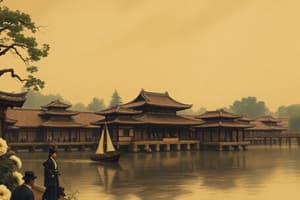Podcast
Questions and Answers
What was established by Tokugawa Ieyasu in 1603 to run a unified Japan?
What was established by Tokugawa Ieyasu in 1603 to run a unified Japan?
- A Democracy
- A Republic
- A Shogunate (correct)
- A Monarchy
Which ideology re-emerged in Japan during the Tokugawa period as a response to Buddhism?
Which ideology re-emerged in Japan during the Tokugawa period as a response to Buddhism?
- Zen Buddhism
- Daoism
- Neo-Confucianism (correct)
- Shintoism
What was a consequence of Japan's isolation policy during the Tokugawa period?
What was a consequence of Japan's isolation policy during the Tokugawa period?
- Increased trade with multiple countries
- Rapid industrialization
- Limited exposure to European ideas (correct)
- Continuous military conflict with Europe
Who primarily suffered from the expulsion policies under Tokugawa Ieyasu?
Who primarily suffered from the expulsion policies under Tokugawa Ieyasu?
Which group did Japan primarily engage in trade with during its isolation?
Which group did Japan primarily engage in trade with during its isolation?
Flashcards
Tokugawa Shogunate
Tokugawa Shogunate
A military government established by Tokugawa Ieyasu in 1603, unifying Japan under his rule and ending the Warring States Period. The Shogunate maintained strict control over the daimyo (feudal lords) and implemented isolationist policies.
Neo-Confucianism in Japan
Neo-Confucianism in Japan
A revival of Confucianism during the Tokugawa period, emphasizing social order, education, and loyalty to the rulers. It influenced Japanese society and governance.
Expulsion of Christians
Expulsion of Christians
The Tokugawa Shogunate's active suppression of Christianity in Japan, including persecution and executions, due to concerns about its influence and potential threat to their authority.
Isolationist Policies
Isolationist Policies
Signup and view all the flashcards
Dutch Trade at Nagasaki
Dutch Trade at Nagasaki
Signup and view all the flashcards
Study Notes
Tokugawa Shogunate (1600-1868)
- Tokugawa Ieyasu established a Shogunate in 1603, unifying Japan under his rule, controlling the daimyo (feudal lords).
- Christians were expelled and many were killed.
- The regime was popular among the elite.
- The Shogunate took power after the Warring States Period.
- Neo-Confucianism, a resurgence of Confucianism in response to Buddhism, gained prominence in Japan.
- Japan isolated itself, cutting off trade with Europeans and avoiding external conflicts for almost 300 years.
- Western trade was limited to contact with the Dutch at Nagasaki Bay, restricting exposure to European ideas.
Studying That Suits You
Use AI to generate personalized quizzes and flashcards to suit your learning preferences.




